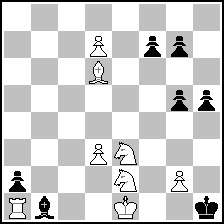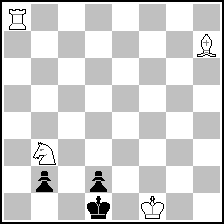
Website founded by
Milan Velimirović
in 2006
23:36 UTC


| |
MatPlus.Net  Forum Forum  General General  Under-promotions Under-promotions |
| |
|
|
|
|
You can only view this page!
| | | (1) Posted by Marek Kwiatkowski [Friday, Feb 16, 2007 22:16] | Under-promotions
One interesting question, in my opinion, should be explained.
In the last time I often read an extended notation regarding promotions of the white Pawn
[e.g. 2.a8Q(R) or 2.a8Q(B)] in orthodox strategic problems (2,3,n#). A white under-promotion (B,R) can be only in the stalemate avoidance theme i.e. 0,0…x % all the created orthodox problems. Only in this theme it has own sense and points at dual. It is disturbing that some composers try to hint that it is a dual in every case. Is it a correct conception?
| | | (2) Posted by Zalmen Kornin [Saturday, Feb 17, 2007 13:11] |
If the under-promotion is not the intended theme, the 'Dual in Promotion' (or 'tolerated promotion dual') would not be, in principle, blamable - but as in others aspects of the finishing of a piece of art, if there IS a way to avoid the double promotion Q/R or Q/B, then it should be advisable to present a single promotion variation:
Z. Kornin (after J. Valladão Monteiro)
original version
 (= 8+7 ) (= 8+7 )
#3
Joaquim Valladão's problem was a 2-er with duals in promotion, the version, extending to a 3-er, intended to eliminate the duals.
An article from the extiguished forum called Rebnora, 'Pawn Becoming Queen as Key' had other examples on this topic
| | | (3) Posted by David Knezevic [Saturday, Feb 17, 2007 14:27] |
My opinion:
The trouble with "under-promotions" is that they exists. The rules of chess do not forbid the bishop promotion if queen promotion does the job (or vice versa), so white under-promotion (B,R) *can be* in all cases, not only in the stalemate. We may call them "minor duals" or "harmless duals" or even "the most harmless minor duals", but the qualification "dual" is always there. A formal rule or convention may save (or enforce) the soundness of problem, but nevertheless the purity is disturbed.
A dual is never innocent, it always does some damage. Even the most powerful and impressive compositions I remember are in my mind inseparably associated with dual-promotion if there was one...
By the way, I don't know if there is any written statement which says it, but, for instance, 2.d8Q and 2.d8B are two different moves. Consequently, the editors and composers who write the alternative in "extended" notation 2.d8Q(B) cannot be blamed regardless how disturbing it may be for others.
| | | (4) Posted by Hauke Reddmann [Monday, Feb 19, 2007 13:11] |
My opinion:
a) it's a dual by definition, b) it's hardly avoidable (you MUST take a
flight, i.e. only short-distance mates are possible), c) only the purists
object unless d) it interferes with the theme. (Not only with underpromotion,
but any "letter" theme also comes to mind)
Hauke
| | | (5) Posted by Frank Richter [Tuesday, Feb 20, 2007 13:21] |
My two cents:
1. I would a double mating move like d8Q or d8B in a direct mate problem not call "a dual" in generally (the only exception are promotion tasks). If we call them duals, we have to assess black promotion moves in the same way. An example:
Matti Myllyniemi
Themes 64 - 7. TT 1971, 5th comm.
 (= 4+3 ) (= 4+3 )
1. Tc8? (2. Lc2) ... b1D!; 1. Td8? (2. Td2) ...b1S!;
1. Ta2! (Zugzwang) ... b1D/b1S 2. Td2/Lc2#
Hannelius. But what about 1.Tc8? b1L! Double refutation of a thematic try?
Of course it is better to avoid promotions in mating moves. Especially Q-mates can be seen only as makeshifts.
2. In all other moves except the mating move my criteria is more strict: Here multiple promotion possibilities are duals in my opinion.
| | | (6) Posted by Uri Avner [Friday, Feb 23, 2007 13:17] |
I would regard this double promotion as quite harmless (except for special cases), especially when the convention is against promoted pieces in the diagram position.
| | | (7) Posted by Marek Kwiatkowski [Monday, Mar 5, 2007 14:12] |
I would like to propose a new term.
Quasi dual - both fields (source and destination) of possible moves as well as continuations of play after these moves are same [e.g. d7-d8Q(B) … ]
| | | (8) Posted by Iļja Ketris [Tuesday, Mar 6, 2007 18:14] |
The FIDE codex makes a special mention of these duals for helpmates:
(2) Helpplay compositions are unsound also if they are dualized, except that in the final move a promotion into different pieces having partially the same power (for example queen/rook or queen/bishop) may be tolerated [16]
| | | (9) Posted by Joose Norri [Tuesday, Mar 6, 2007 18:45] |
Well then, can we tolerate the dual d8 rose / d8 rook? They have partially the same powers, they both attack d2, can thus checkmate a king there.
| | | (10) Posted by Marek Kwiatkowski [Tuesday, Mar 6, 2007 19:57] |
Sorry, but I thought that it is evident that fairy pieces should be promoted always clear.
| | | (11) Posted by Marek Kwiatkowski [Tuesday, Mar 6, 2007 20:36] |
The term “quasi dual�? concerns only promotions Q(R) and Q(B).
| | | (12) Posted by Joose Norri [Wednesday, Mar 7, 2007 04:21] |
Yes that's the convention. But I don't understand the logic behind it. For each fairy problem containing fairy pieces, I suppose then that's the orthodox set for that particular problem. If there's a thematic reason for the fairy pieces otherwise (and there always is), I can't see why the unimportant dualpromotion is so bad. It's easy to find reasons why one can't differentiate between a fairy promotion and an orthodox one - be it that it's not very elegant. It's just an extrapolation. Of course, if such dual promotions are not to be tolerated, then they should not be tolerated in orthodox helpmates either.
Some years ago, a friend of mine said that Q/R and Q/B promotions control that said square along the same line, whereas Q/rose do not. This is a common fallacy. In chess, there is no such a thing as 'a line'; chess is not 2dimensional. It has 64 squares and we order them into a 8x8 square, because that way it's easier for us to comprehend what's going on. We might as well have a single line of 64 squares, and the movements of the pieces would be easy to define. Logically, that's what we have.
| | | (13) Posted by Hauke Reddmann [Wednesday, Mar 7, 2007 18:32]; edited by Hauke Reddmann [07-04-05] |
Non-sequitur alert :-)
For the mating move, take...
Q instead of B - always possible (yeah, Madrasi, I know :-)
B instead of Q - not always possible
N instead of S - always possible (if allowed)
S instead of Moa - always possible
R instead of Rose - not always possible
Rose instead of R - not always possible
Lion instead of G - always possible...if there are Lions
and Grasshoppers in the original position
etc.
Thus, in an orthodox fairy {:-)} with N, I would see
d8S where d8N is "intended" not see as dual. And to Moa
can't be promoted at all. As it is not *possible* to force
a promotion into a weaker piece.
Whereas Rose/Rook in your example is easy to differentiate.
(Hey, I see a theme lurking - d8Q,Rose,G as dual-free mates
on a fixed K! Plus some more fairys I have to look up first :-)
Hauke
EDIT: Kf2 Xg2 Xg4 Bh7/Kh2 Bf3 Bh3 Ge2
1...hxg2/fxg2/Gxg2 2.h8D/h8Ro/h8G#
(This is just a scheme, even the mates aren't mate yet)
SON OF EDIT: Original electronically submitted. Only had to
add 4 more pieces. Nice construction task for you all :-)
| |
No more posts |
MatPlus.Net  Forum Forum  General General  Under-promotions Under-promotions |
|
|
|
 ISC 2024
ISC 2024 Forum
Forum  General
General  Under-promotions
Under-promotions 


